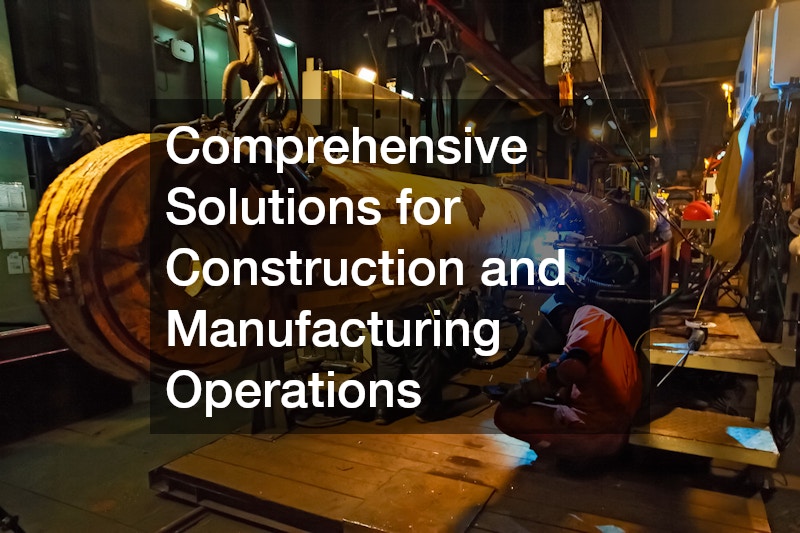Disclaimer: Concordia Research. This site provides general content for informational purposes only.
Navigating the complex landscape of modern construction and manufacturing requires a multifaceted approach that spans equipment procurement, process automation, waste management, facility design, and marketing visibility. From sourcing the right bulk material handling equipment to leveraging cutting-edge robotic fabrication, organizations must align operational efficiency with safety, regulatory compliance, and cost control. Whether you’re outfitting a new commercial greenhouse, expanding your factory’s welding capabilities, or managing a large-scale construction site, integrating best-in-class solutions ensures that every phase—from raw-material intake to final assembly—operates seamlessly. This in-depth guide explores key areas of focus, practical strategies, and leading industry practices to help your operation achieve peak productivity while remaining adaptable to evolving market demands.
Understanding Material Flow and Bulk Handling Systems
Effective material management begins with evaluating your requirements for storage, conveyance, and dispensing. In heavy industry, bulk material handling equipment such as industrial conveyors, hoppers, and pneumatic systems enables consistent throughput of raw inputs like aggregates, powders, and recycled feedstocks. Properly sized silos and storage bins, combined with automated weighing and batching controls, eliminate manual bottlenecks and reduce the risk of overloading. For manufacturing facilities that process high-volume inputs—whether grains in an agritech plant or minerals in cement production—implementing closed-loop feedback between load cells and control software maintains precise material flow.
Selecting the right equipment involves aligning capacity specifications with floor-space constraints and throughput targets. Modular conveyor segments can be reconfigured as production demands shift, while mobile bins and hoppers facilitate cross-line transfers without extensive downtime. Integrating dust-control measures, such as enclosed chutes and local exhaust ventilation, safeguards worker health and minimizes environmental impact. By investing in scalable bulk material handling equipment solutions, operations gain flexibility to accommodate seasonal surges, product-line changes, and future expansion with minimal rework.
Embracing Automation with Robotic Fabrication
Automation remains a cornerstone of advanced manufacturing, with robotic fabrication systems transforming welding, material cutting, and assembly tasks. Industrial robots equipped with multi-axis arms deliver precise, repeatable weld beads—critical for meeting stringent structural tolerances on components destined for heavy machinery or architectural steel frameworks. Automated laser cutters and water-jet machines handle complex part geometries while maximizing raw-material utilization, reducing scrap costs and accelerating production cycles.
Deploying collaborative robots (cobots) alongside human operators can further boost productivity on tasks requiring both dexterity and flexibility. Cobots assist with part loading, tool changes, and quality-inspection operations, freeing skilled technicians to focus on programming, maintenance, and continuous-improvement initiatives. Integrating vision-system feedback enables real-time defect detection, with machine-learning algorithms refining weld-quality thresholds and minimizing rework. By incorporating robotic fabrication into your workflow, you achieve higher throughput, improved process consistency, and faster time to market for precision components.
Optimizing Packaging and Waste Management with Contract Packaging
Efficient contract packaging services play a pivotal role in reducing labor costs and ensuring consistent quality across product lines. Third-party specialists handle everything from kitting and unitizing to shrink-wrapping, labeling, and palletizing finished goods—tasks that can otherwise burden in-house teams during peak seasons. Partnering with a reputable contract packaging provider allows you to scale fulfillment capacity rapidly without capital investment in specialized machinery.
On the waste management front, integrating a reliable dumpster rental service into your site plan streamlines debris removal during construction or plant maintenance. Having a range of container sizes—from 10-yard bins for light debris to 40-yard roll-offs for demolition waste—ensures you never disrupt workflows waiting for off-site pickups. Scheduling regular pickups and implementing on-site sorting bins for recyclables and hazardous materials also supports sustainability initiatives and local regulatory compliance. By outsourcing packaging and waste handling, your core teams remain focused on value-added activities, while service partners deliver predictable, turnkey solutions.
Ensuring Structural Integrity for Roofers and Facility Projects
Roofing and building envelope specialists must coordinate closely with project managers and architect-engineers to deliver watertight, energy-efficient systems. Whether your project involves commercial greenhouses with polycarbonate panels or large-span industrial roofs with insulated metal panels, selecting the optimal roofing materials depends on factors such as load ratings, thermal performance, and local weather patterns. Collaborating with certified roofers who hold manufacturer credentials ensures proper installation techniques—sealing, membrane adhesion, and fastener placement—are followed to prevent future leaks and extend service life.
For projects with stringent climate-control requirements, combining reflective coatings with rigid insulation and roofing ventilation reduces solar heat gain and lowers HVAC energy consumption. Integrating skylight systems or translucent panels in greenhouse structures maximizes natural light for plant growth while maintaining structural strength. By prioritizing coordination between design teams and roofers, you safeguard project schedules, avoid costly callbacks, and deliver durable, efficient facilities that meet both operational and sustainability goals.
Expanding Capacity with Heavy Equipment Sales and Rentals
Growing operations often require additional machinery—excavators, loaders, graders, and forklifts—to meet production targets or complete civil-works projects. Reviewing options for heavy equipment for sale versus lease or rental involves comparing total cost of ownership, expected utilization rates, and maintenance budgets. Purchasing units offers long-term savings if usage is consistent, while rentals provide flexibility for short-term peaks without tying up capital. Many dealers bundle service agreements and operator training with equipment sales, enhancing uptime and ensuring proper asset utilization.
When flexibility is paramount, equipment rental partners supply specialized machines—telehandlers, tracked skid steers, and compact excavators—for agile deployment across multiple sites. Integrating a mixed-fleet approach, with core assets owned and supplementary units rented as needed, optimizes cash flow and scales resources in step with project workloads. Establishing preferred relationships with equipment suppliers also unlocks volume discounts, priority maintenance slots, and early access to demo models equipped with the latest technology.
Customizing Workspaces for Commercial Greenhouses and Beyond
Industrial operations extend beyond traditional factories to specialized environments such as commercial greenhouses for horticulture, agritech prototyping, or biotech research. These facilities require end-to-end design—from climate-controlled benches and irrigation systems to integrated particulate filters and access panels for heavy-equipment transport. Coordinating with agricultural engineers, structural consultants, and greenhouse-equipment suppliers ensures that glazing materials, frame members, and ventilation controls align with both botanical needs and production efficiency.
In multi-purpose manufacturing plants, partitioned cleanrooms, laminar-flow stations, and containment suites support disciplines from food processing to pharmaceuticals. Defining precise material flows—raw ingredients in, finished products out—minimizes cross-contamination and streamlines quality-control sampling. Configuring floor plans for forklifts and AGVs to navigate without interference maximizes throughput while preserving safety. By tailoring facility layouts to operational demands, organizations unlock continuous production cycles and support rigorous product-quality standards.
Elevating Brand Visibility with Business Signs
Site visibility and clear wayfinding play crucial roles in visitor safety and brand awareness. Installing high-impact business signs—monument signs, building-mounted channel letters, and LED message boards—helps external partners, employees, and clients locate your facility quickly. Coordination between sign fabricators, installers, and local permitting authorities ensures compliance with zoning regulations, illuminated-sign safety codes, and electrical-connection requirements.
On construction sites, temporary signage for traffic management, hazard warnings, and directional wayfinding supports OSHA compliance and reduces liability risks. Branded sign packages also reinforce corporate identity on job sites, showcasing vendor credentials and contractor affiliations. By integrating professional signage into both permanent installations and project-specific setups, organizations project a cohesive image and streamline on-site communications.
Facilitating Vertical Lifts with Crane Rental Services and Tower Crane Dealers
Lifting heavy materials and prefabricated assemblies demands dependable crane solutions. Partnering with leading crane rental services allows you to select from mobile hydraulic units, rough-terrain cranes, and all-terrain crawler models to suit site conditions. For long-term projects, collaborating with tower crane dealers secures self-erecting or hammerhead cranes that provide elevated load radii, maximizing reach for high-rise construction or industrial refits.
Proper planning with crane specialists includes site surveys, ground-bearing calculations, and lift-path sequencing to minimize interference with existing structures and utility lines. Integrating mobile crane setups for structural steel placements can reduce assembly time by synchronizing with robotic fabrication workflows, while tower cranes handle heavy modules delivered by over-dimensional transport. By engaging crane rental services early in design phases and consulting tower crane dealers on model selection, your project team ensures seamless load handling and adherence to stringent safety protocols.
Integrating Support Services for End-to-End Project Success
Completing large-scale construction or manufacturing initiatives demands a holistic ecosystem of support services. From permitting and environmental assessments to staffing and quality inspections, aligning specialty contractors with core teams ensures continuity and accountability. Waste-stream management via scheduled dumpster rental service pickups keeps sites tidy and compliant, while contract packaging providers prepare finished components for secure shipment to distributors or final customers.
Regular preventive maintenance—whether on robotic fabrication cells, conveyor lines, or roofing membranes—prolongs asset life and averts costly unplanned downtime. Partnering with maintenance specialists who offer remote monitoring and predictive analytics transforms reactive repairs into scheduled tune-ups, optimizing budgets and reinforcing production reliability. By orchestrating a network of expert service providers alongside equipment suppliers, you create a resilient framework capable of adapting to evolving operational requirements.
Building Resilient, Scalable Operations
Modern construction and manufacturing enterprises thrive by integrating best-of-breed solutions across equipment, automation, facilities, and support services. From sourcing bulk material handling equipment and deploying robotic fabrication systems to partnering with contract packaging experts and maintaining streamlined waste removal through a reliable dumpster rental service, every component contributes to overall efficiency. Roofers and greenhouse specialists ensure that structures remain weather-tight and climate-controlled, while heavy equipment for sale and rental fill capacity gaps as projects evolve. Business signs and crane rental services amplify visibility and logistical capability, respectively, and collaboration with tower crane dealers sustains vertical construction needs.
By embracing a comprehensive, strategic approach—grounded in data-driven decision-making, vendor partnerships, and continuous improvement—organizations can reduce lead times, control costs, and maintain peak productivity across diverse project types. In an era of rapid technological advancement and competitive pressures, operations that prioritize integrated solutions and flexible resource models will lead the industry in delivering on time, on budget, and with uncompromising quality.



